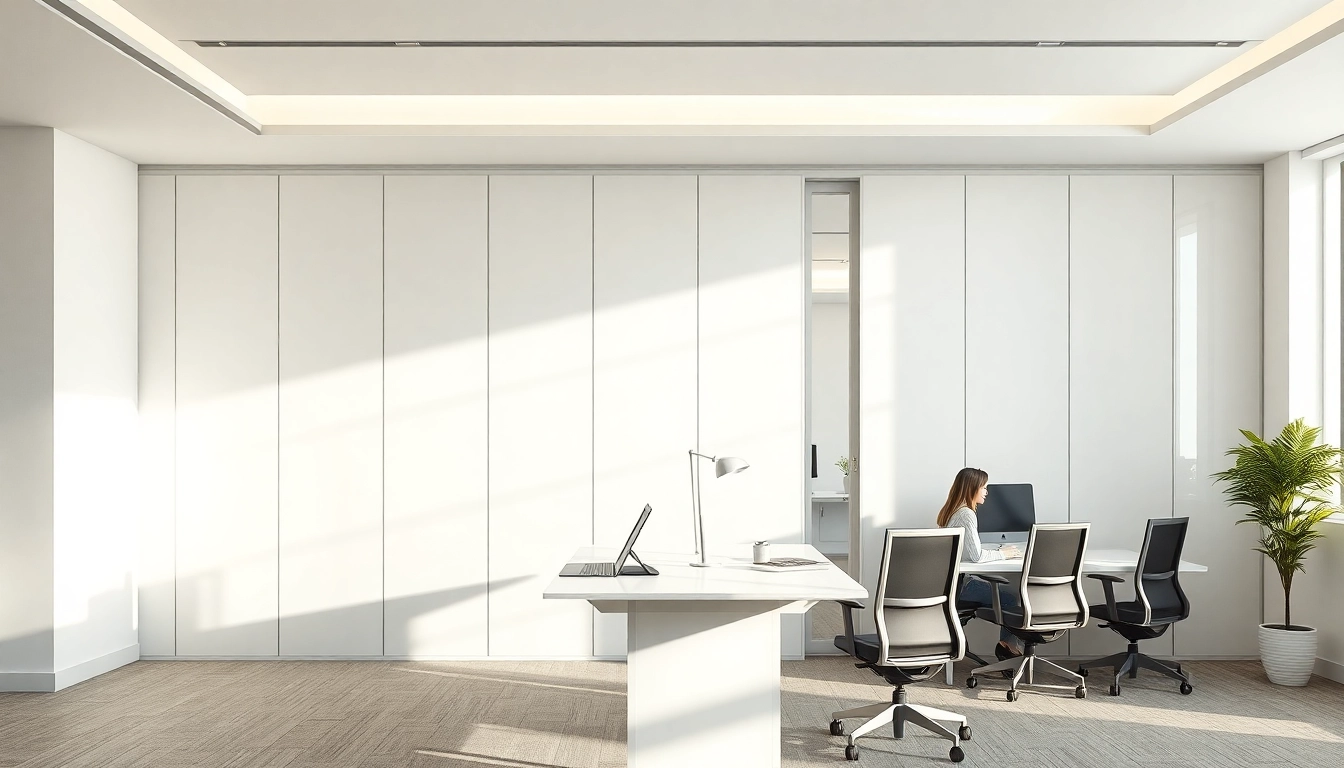Understanding Folding Partition Walls
Definition and Purpose
A Folding Partition Wall is a versatile architectural solution designed to transform spatial configurations in both commercial and residential settings. These movable walls can be retracted or expanded based on the requirements of the moment, allowing for seamless transitions between open and enclosed spaces. Their primary purpose is to enhance functionality within a room by enabling variable layouts, accommodating diverse activities, and improving space utilization.
Types of Folding Partition Walls
Folding partition walls come in various styles and materials, each suited for specific applications and aesthetics:
- Accordion Partitions: Characterized by their pleated design, accordion partitions are lightweight and portable, making them ideal for temporary divisions.
- Operable Partitions: These are engineered for more durability, often incorporating soundproofing materials and offering better thermal insulation.
- Glass Partition Walls: Combining aesthetics with functionality, glass partitions allow natural light to flow between spaces while providing a sense of openness.
- Acoustic Partitions: Designed to enhance sound control, these walls are perfect for environments where noise reduction is crucial, such as conference rooms.
Benefits of Folding Partitions
The advantages of folding partition walls extend beyond mere aesthetics. Some key benefits include:
- Space Optimization: Folding partitions allow spaces to be customized according to specific needs, thus maximizing the utility of a room.
- Flexibility: Users can reconfigure spaces quickly and effortlessly, catering to different activities or group sizes.
- Cost-Effectiveness: By avoiding extensive renovations, folding partitions present a more affordable option for space division.
- Enhanced Acoustics: Many folding partitions are designed with sound insulation properties, creating quieter environments suitable for meetings or educational settings.
- Design Versatility: Available in a plethora of materials, colors, and finishes, folding partitions can complement a variety of interior design styles.
How to Choose the Right Folding Partition Wall
Assessing Your Space Needs
Before selecting a folding partition, it’s essential to comprehensively assess the spatial requirements. Consider the following factors:
- Usage Frequency: Determine how often the space will need to be reconfigured. High-traffic areas may benefit from more robust systems.
- Size of the Space: The dimensions of the room will influence the type of partition you choose, including its height and width.
- Operational Ease: Evaluate the ease of use and whether manual or automated systems are preferable based on user needs.
Material Options and Aesthetics
The materials used in folding partitions significantly affect their functionality and appearance. Common materials include:
- Plywood: Often used for cost-effectiveness and lightweight properties.
- Steel: Offers durability and strength, suitable for high-traffic environments.
- Glass: Ideal for modern aesthetics, allowing light penetration while providing spatial distinctions.
- Melamine: A budget-friendly option that mimics the look of real wood and comes in various finishes.
Selecting an appropriate finish is crucial as it contributes to the overall design theme and ambiance of the space.
Cost Considerations
Understanding the costs involved in purchasing and installing folding partition walls is crucial for budgeting. Key considerations include:
- Material: The choice of materials has a significant impact on the overall cost, with premium materials typically costing more.
- Size and Design: Custom designs may incur additional costs.
- Installation Fees: Professional installation might be necessary, adding to the overall budget. Ensure to obtain multiple quotes to find the best pricing.
- Maintenance and Repairs: Consider the long-term costs associated with upkeep and potential repairs over time.
Installation Process of Folding Partition Walls
Preparing Your Space
Preparation is key to ensuring a smooth installation process. Steps to prepare your space include:
- Cleansing the Area: Remove any obstacles and debris to facilitate the installation process.
- Measuring Accurately: Ensure that you have precise measurements to avoid complications during installation.
- Evaluating Structural Integrity: Check that the walls or ceiling can support the partition system being installed.
Professional Installation vs DIY
While some homeowners may opt to take a DIY approach, hiring professionals usually benefits complex installations:
- Reasons for Professional Installation: Ensures that the installation is performed to code, minimizes potential damage, and leverages expert knowledge.
- Benefits of DIY: Cost savings and the ability to personalize versus challenges including skill level and time constraints.
Consider the scale of the installation and whether professional assistance is necessary for optimal results.
Maintenance Tips
Maintaining your folding partition walls can prolong their life and functionality. Here are some helpful tips:
- Regular Cleaning: Dust and clean the surface regularly to prevent buildup, especially on tracks and hinges.
- Inspect Mechanisms: Regularly check the operation of folding systems and lubricate hinges or tracks as needed.
- Monitor for Damage: Look for signs of wear or damage, particularly in high-use areas, and address these issues promptly.
Applications of Folding Partition Walls in Various Settings
Commercial Use Cases
In commercial environments, folding partition walls serve a multitude of purposes:
- Conference Rooms: Easily reconfigure spaces for meetings, workshops, or client consultations.
- Event Venues: Create adaptable spaces for banquets, exhibitions, or parties based on occupancy.
- Office Spaces: Promote collaborative work environments while providing private areas for focused tasks.
Residential Applications
Folding partitions are increasingly popular in residential design due to their versatility:
- Home Offices: Create a secluded work area that can be opened up when not in use.
- Children’s Play Areas: Designate play zones that can be closed off when guests arrive.
- Guest Accommodations: Create privacy for overnight guests in adaptable layouts.
Educational and Institutional Spaces
Educational institutions benefit substantially from folding partition systems:
- Classrooms: Easily convert classrooms into collaborative learning environments or large group settings.
- Auditoriums: Allow for flexible seating arrangements for various events.
- Libraries: Create quiet zones for study while maintaining open areas for interaction.
Trends in Folding Partition Wall Design
Modern Materials and Technologies
Advancements in materials and technology have redefined folding partition wall design:
- Smart Glass Technology: Incorporates dynamic transparency, allowing glass partitions to switch from transparent to opaque.
- Durable and Lightweight Materials: Innovations in composite materials reduce weight while maintaining strength.
- Integrated Technology: Some systems offer integrated audio-visual solutions for meetings and presentations.
Sustainability in Partition Design
As sustainability becomes a priority, many manufacturers are focusing on eco-friendly materials and production methods:
- Recyclable Materials: Partition systems are increasingly made from materials that can be recycled at the end of their lifecycle.
- Energy Efficiency: Designs that incorporate insulating materials contribute to lower energy usage and costs.
Future Outlook and Innovations
Looking ahead, the folding partition industry is poised for significant growth:
- Customization: Demand for bespoke solutions will likely drive innovation in design and technology.
- Integration with Smart Building Systems: Increased connectivity and automation will enhance the user experience.
- Increased Focus on Aesthetics: As spaces become more design-conscious, the demand for attractive and functional solutions will rise.



